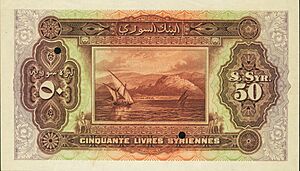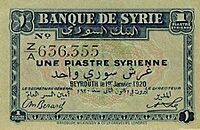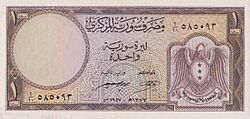Syrian pound facts for kids
Quick facts for kids Syrian pound |
|
|---|---|
| ISO 4217 Code | SYP |
| User(s) | |
| Inflation | 28.1% |
| Source | The World Factbook, 2017 est. |
| Subunit | |
| 1⁄100 | piastre (p) |
| Coins | LS 5, LS 10, LS 25, LS 50 |
| Banknotes | LS 50, LS 100, LS 200, LS 500, LS 1,000, LS 2,000, LS 5,000 |
The Syrian pound or lira (Arabic: الليرة السورية, romanized: al-līra as-sūriyya) is the money used in Syria. It's often called LS or SP in English, and ل.س in Arabic. The Central Bank of Syria is in charge of making and distributing it.
The pound is officially divided into 100 smaller units called piastres. However, piastre coins are not made or used anymore.
For a long time, banknotes had Arabic writing on one side and French on the other. After 1958, English was used instead of French on the back of the notes. Coins used both Arabic and French until Syria became independent, then only Arabic.
Contents
The Story of the Syrian Pound
For about 400 years, when Syria was part of the Ottoman Empire, the Ottoman lira was its main money. After the Ottoman Empire ended, France took control of Syria. During this time, the Egyptian pound was used in Syria and other nearby areas like Lebanon.
The French government wanted its own money for Syria and Lebanon. So, in 1919, they introduced the Syrian-Lebanese pound. This new money was linked to the French franc. This meant its value was set based on the French franc.
A bank called the Banque de Syrie (later renamed Banque de Syrie et du Grand-Liban) was given the power to print this new money. For 15 years, starting in 1924, this bank issued the Syro-Lebanese pound.
In 1939, the bank changed its name again to the Banque de Syrie et du Liban. In 1941, the Syrian pound's value was linked to the British Pound Sterling instead of the French franc. This happened when British and French forces took control of Syria during World War II.
After the war, in 1946, the pound was linked back to the French franc. Then, in 1947, Syria joined the International Monetary Fund (IMF). At this point, the Syrian pound was linked to the U.S. dollar. One U.S. dollar was worth about 2.19 Syrian pounds. This rate stayed the same until 1961.
In 1948, the money used in Lebanon and Syria became completely separate. From 1961 onwards, Syria had official exchange rates, but also a "black market" rate. This black market rate showed the real value of the Syrian pound, especially in nearby countries like Jordan and Lebanon.
How the Syrian Civil War Affected the Pound
The Syrian Civil War, which started in 2011, caused many people to move their money to banks in other countries. These countries included Lebanon, Jordan, Egypt, and Turkey.
Also, countries like the United States and the European Union placed sanctions on Syria. Sanctions are like strict rules that limit a country's ability to trade or use the global banking system. To get around these rules, Syrians often used banks in neighboring countries, especially Lebanon, for their money transactions.
Because of these challenges, the official value of the Syrian pound dropped a lot. For example, in March 2011, one US dollar was worth about 47 Syrian pounds. By July 2017, it was 515 Syrian pounds for one dollar. By April 2023, it had fallen to 7500 Syrian pounds for one dollar.
In 2019, Syrian President Bashar Al-Assad explained that even when areas were taken back from groups fighting the government, it didn't always help the Syrian pound. This was because those groups had been bringing in dollars, and when they left, those dollars stopped coming into the area.
The Exchange Rate of the Syrian Pound
The exchange rate tells you how much one currency is worth compared to another. For example, how many Syrian pounds you can get for one US dollar.
In the early 2000s, one US dollar was usually worth about 50 Syrian pounds. However, since the Syrian Civil War began in 2011, the unofficial exchange rate has changed a lot.
In November 2019, after protests in Lebanon, the black market rate for the Syrian pound dropped sharply. This happened because Lebanese banks made it hard for Syrians to get their money out. The black market rate fell from around 765 Syrian pounds for one US dollar to over 1,000 Syrian pounds by January 2020. The official rate set by the central bank was much lower, around 434 Syrian pounds to the dollar.
During the COVID-19 pandemic in Syria, the Syrian pound continued to lose value. By May 2020, one US dollar was worth more than 1,600 Syrian pounds on the black market. A month later, it passed 2,000, and then 3,000 Syrian pounds for one dollar.
In some parts of northern Syria controlled by Turkey, people started using the Turkish lira instead of the Syrian pound. This was because the Syrian pound was losing so much value.
By March 2021, the Syrian pound hit a new low, with one US dollar buying 4,000 Syrian pounds on the black market. This was partly due to the Lebanese pound also losing a lot of its value. By the end of 2022, one US dollar was worth 7,150 Syrian pounds on the black market.
As of May 2023, the official exchange rate was 7,500 Syrian pounds for one US dollar. On the black market, it was even higher, at 9,100 Syrian pounds for one US dollar.
Syrian Coins
In 1921, the first Syrian coins were made. These were half-piastre coins. Later, in 1926, 2 and 5 piastre coins were introduced. In 1929, silver coins for 10, 25, and 50 piastres were made, along with a 1 piastre coin with a hole in the middle.
During World War II, some simple, undated emergency coins were made.
Between 1947 and 1948, new coins were introduced. These included 2.5, 5, 10, 25, 50 piastres, and 1 Syrian pound coins. Over time, the metals used for coins changed. For example, silver was replaced by nickel in 1968.
In 1996, because of high inflation (meaning money lost its value quickly), new coins were made for 1, 2, 5, 10, and 25 Syrian pounds. The 25 pound coin was made of two different metals. In 2003, some coins were made with special features to prevent fakes.
On December 26, 2018, the Central Bank of Syria introduced a 50 Syrian pound coin. This coin was meant to replace the 50 pound banknote. However, due to very high inflation, by December 2022, only the 50 pound coin was still commonly used, as other coins had become almost worthless.
Syrian Banknotes
In 1919, the Banque de Syrie started printing banknotes for 5, 25, and 50 piastres, and for 1 and 5 Syrian pounds. In 1920, they added notes for 10, 25, 50, and 100 Syrian pounds.
By 1930, notes for less than 1 Syrian pound were no longer printed. The bank that issued the money changed its name a few times, eventually becoming the Banque de Syrie et du Liban in 1939.
Between 1942 and 1944, the government itself printed notes for 5, 10, 25, and 50 piastres. In the early 1950s, a new institution took over printing notes for 1, 5, 10, 25, 50, and 100 Syrian pounds.
In 1957, the Central Bank of Syria began issuing banknotes. In 1958, English replaced French on the banknotes. New notes were issued for 1, 5, 10, 25, 50, 100, and 500 Syrian pounds. The designs of some notes were updated in 1966 and again in 1976-1977.
In 1997 and 1998, a new series of banknotes was introduced. These were for 50, 100, 200, 500, and 1,000 Syrian pounds. The smaller values were now covered by coins. In 2009, the 50, 100, and 200 pound notes got completely new designs.
New notes for 500 pounds were released in 2014, 1,000 pounds in 2015, 2,000 pounds in 2017, and 5,000 pounds in 2021.
Banknotes from the 2009 Series
On July 27, 2010, the Central Bank of Syria released a new series of banknotes. These notes, dated 2009, included 50, 100, and 200 Syrian pound denominations. An Austrian designer named Robert Kalina created these new designs.
Later, the Central Bank issued new 500 and 1,000 pound notes in 2014 and 2015. The back of the new 1,000 pound note shows a Roman mosaic picture found in Deir al-Adas. In 2017, President Bashar al-Assad's picture was added to the 2,000 pound note. The 5,000 pound note was released in January 2021.
| Image | Value | Dimensions (millimeters) | Main color | What's on the note? | First made in | ||
|---|---|---|---|---|---|---|---|
| Front | Back | Front | Back | ||||
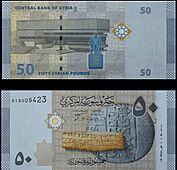 |
£50 | 134 × 64 | Greyish blue | An ancient tablet from Ugarit and a tablet from Ebla | Al-Assad National Library and a statue of Hafez Al-Assad | 2009 | |
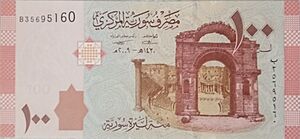 |
 |
£100 | 138 x 64 | Reddish orange | A stone gate and the Roman Theatre at Bosra | The dome of the Treasury at the Umayyad Mosque, the Central Bank of Syria, and an old coin | 2009 |
| £200 | 144 x 64 | Brown | The Norias of Hama (water wheels) | Ceiling of the Temple of Bel in Palmyra | 2009 | ||
| £500 | 149 x 64 | Blue | Damascus Opera House | A mosaic called "Mosaic of the Musicians" from Maryamin, Homs | 2013 | ||
| £1000 | 155 x 64 | Green | Roman Theatre at Bosra | A Roman mosaic showing a grape harvest in Deir al-Adas | 2013 | ||
| £2000 | 158 x 64 | Purple | President Bashar al-Assad and the Umayyad Mosque | The Syrian Parliament | 2015 | ||
 |
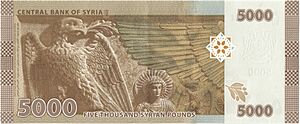 |
£5000 | 157 x 64 | Brown | A Syrian soldier statue and the Syrian flag | An eagle and a painting of Yarhibol from the Temple of Baalshamin in Palmyra | 2019 |
See Also
- Economy of Syria
- Lebanese pound
| Current SYP exchange rates | |
|---|---|
| From Google Finance: | AUD CAD CHF EUR GBP HKD JPY USD TRY JOD EUR |
| From Yahoo! Finance: | AUD CAD CHF EUR GBP HKD JPY USD TRY JOD EUR |
| From XE.com: | AUD CAD CHF EUR GBP HKD JPY USD TRY JOD EUR |
| From OANDA: | AUD CAD CHF EUR GBP HKD JPY USD TRY JOD EUR |
| From fxtop.com: | AUD CAD CHF EUR GBP HKD JPY USD TRY JOD EUR |
from Lira news: USD TRY


